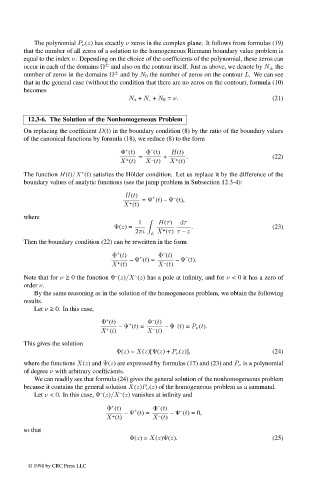Page 628 - Handbook Of Integral Equations
P. 628
The polynomial P ν (z) has exactly ν zeros in the complex plane. It follows from formulas (19)
that the number of all zeros of a solution to the homogeneous Riemann boundary value problem is
equal to the index ν. Depending on the choice of the coefficients of the polynomial, these zeros can
±
occur in each of the domains Ω and also on the contour itself. Just as above, we denote by N ± the
±
number of zeros in the domains Ω and by N 0 the number of zeros on the contour L. We can see
that in the general case (without the condition that there are no zeros on the contour), formula (10)
becomes
N + + N – + N 0 = ν. (21)
12.3-6. The Solution of the Nonhomogeneous Problem
On replacing the coefficient D(t) in the boundary condition (8) by the ratio of the boundary values
of the canonical functions by formula (18), we reduce (8) to the form
–
+
Φ (t) Φ (t) H(t)
= + . (22)
+
+
–
X (t) X (t) X (t)
+
The function H(t)/X (t) satisfies the H¨ older condition. Let us replace it by the difference of the
boundary values of analytic functions (see the jump problem in Subsection 12.3-4):
H(t) + –
= Ψ (t) – Ψ (t),
+
X (t)
where
1 H(τ) dτ
Ψ(z)= . (23)
+
2πi L X (τ) τ – z
Then the boundary condition (22) can be rewritten in the form
+
–
Φ (t) + Φ (t) –
– Ψ (t)= – Ψ (t).
+
–
X (t) X (t)
–
–
Note that for ν ≥ 0 the function Φ (z)/X (z) has a pole at infinity, and for ν < 0 it has a zero of
order ν.
By the same reasoning as in the solution of the homogeneous problem, we obtain the following
results.
Let ν ≥ 0. In this case,
+
–
Φ (t) + Φ (t) –
– Ψ (t)= – Ψ (t)= P ν (t).
–
+
X (t) X (t)
This gives the solution
Φ(z)= X(z)[Ψ(z)+ P ν (z)], (24)
where the functions X(z) and Ψ(z) are expressed by formulas (17) and (23) and P ν is a polynomial
of degree ν with arbitrary coefficients.
We can readily see that formula (24) gives the general solution of the nonhomogeneous problem
because it contains the general solution X(z)P ν (z) of the homogeneous problem as a summand.
–
–
Let ν < 0. In this case, Φ (z)/X (z) vanishes at infinity and
+
–
Φ (t) + Φ (t) –
– Ψ (t)= – Ψ (t)=0,
–
X (t) X (t)
+
so that
Φ(z)= X(z)Ψ(z). (25)
© 1998 by CRC Press LLC
© 1998 by CRC Press LLC
Page 611

